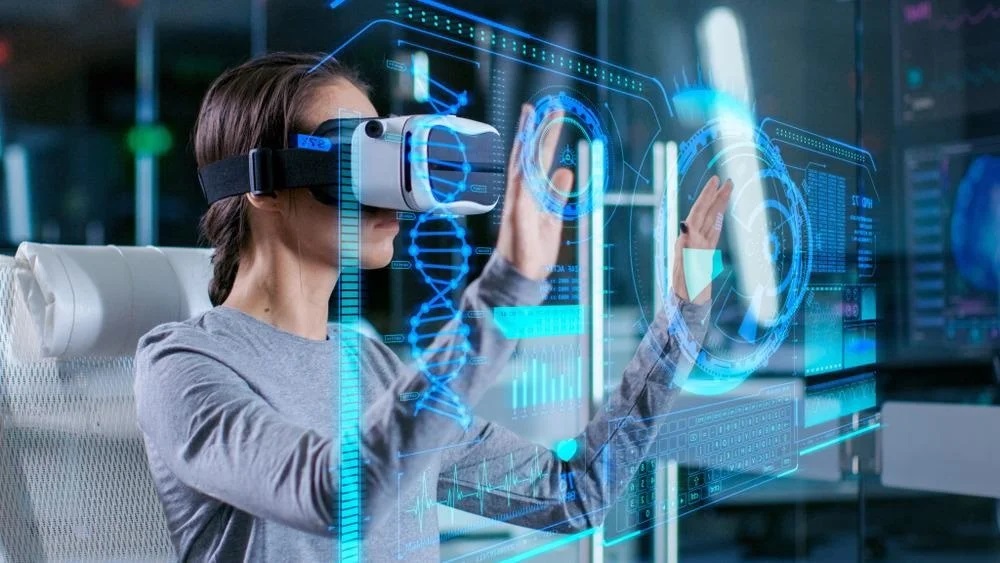Education & Career Trends: July 28
Curated by the Knowledge Team of ICS Career GPS

- Excerpts are taken from an article published on analyticsinsight.net.
Augmented Reality or AR has swiftly emerged as a revolutionary technology, captivating individuals across the globe with its seamless integration of virtual and physical realms. With its diverse applications in various industries, AR has transformed the way we perceive and interact with our surroundings.
In this article, we will delve into the intricacies of AR, exploring its definition, underlying technology, and the captivating mechanisms that bring it to life.
Defining Augmented Reality
Augmented Reality, often abbreviated as AR, is a technology that overlays computer-generated elements, including visuals, sounds, and haptic feedback, onto the real world, enriching the user’s perception and interaction with their environment. Unlike virtual reality, which creates an entirely immersive digital environment, AR enhances the existing reality by integrating virtual elements seamlessly into the user’s field of view.
Understanding the Technology Behind Augmented Reality
To comprehend how AR technology works, it is crucial to understand the core technological components that power it. AR harnesses advanced algorithms and hardware integration to merge virtual and real-world elements convincingly.
Let’s explore some key technologies and techniques employed in AR systems:
1. Computer Vision
- Computer vision, a subset of artificial intelligence, empowers machines to interpret and understand visual data.
- In the context of AR, computer vision algorithms analyse real-world imagery, detecting and tracking objects, surfaces, and markers.
- This enables virtual objects to be accurately placed and anchored within the environment.
2. Simultaneous Localisation and Mapping (SLAM)
- SLAM is a technique that allows AR devices to map and track their position within the physical space in real-time.
- By leveraging data from sensors such as cameras, gyroscopes, and accelerometers, SLAM algorithms construct a 3D model of the surroundings and track the device’s movement within it.
- This ensures that virtual objects maintain their positional accuracy.
3. Tracking Technologies
- Various tracking technologies play a vital role in AR experiences.
- Marker-based tracking utilises pre-defined visual markers, such as QR codes or fiducial markers, to precisely position virtual content.
- Markerless tracking relies on computer vision and feature detection to track objects or surfaces in the real world.
- Object recognition allows AR devices to identify and track specific objects, enhancing interactivity and providing contextual information.
4. Displays and Optics
- AR devices employ different display technologies, including smartphones, tablets, specialised headsets, and smart glasses.
- These devices utilise transparent or semi-transparent screens, projectors, or holographic displays to superimpose virtual content onto the user’s field of view.
- Optics, such as lenses and mirrors, are essential for aligning and focusing virtual elements with the real world, ensuring a seamless and convincing user experience.
The Mechanics of Augmented Reality
The process of creating an AR experience involves several steps, each contributing to the final result. Here’s a simplified breakdown of how AR works:
1. Data Capture
- AR systems gather real-time data from various sensors, such as cameras, microphones, GPS, and motion sensors.
- These sensors capture visual, auditory, and spatial information, forming the foundation for the AR experience.
2. Environment Recognition
- Using computer vision and tracking technologies, the AR device analyses the captured data to recognise objects, surfaces, and markers.
- This establishes a contextual understanding of the user’s environment.
3. Content Generation
- Based on the recognised environment, virtual content is generated, such as 3D models, animations, or textual information.
- This content is designed to augment the user’s perception of reality and can vary depending on the specific AR application.
4. Alignment and Registration
- AR systems utilise algorithms and positional tracking to precisely align and register the virtual content with the real world.
- This ensures that virtual objects appear seamlessly integrated and anchored within the user’s physical surroundings.
5. Rendering and Display
- Once the virtual content is aligned, it is rendered and displayed on the AR device’s screen or through specialised headsets or glasses.
- Optical components ensure that the virtual elements are visually merged with the real world, giving users the impression of interacting directly with the augmented environment.
6. User Interaction
- AR empowers users to interact with virtual content through gestures, voice commands, touchscreens, or specialised input devices.
- These interactions may trigger additional visual or auditory feedback, enhancing the overall immersion and engagement.
Applications of Augmented Reality
The applications of AR are vast and continue to expand across industries. Some notable examples include:
1. Gaming and Entertainment
- AR gaming has gained immense popularity, exemplified by games like Pokémon Go, where virtual creatures are superimposed onto the real-world environment.
- Additionally, AR is transforming entertainment experiences, enabling immersive storytelling and interactive exhibitions.
2. Education and Training
- AR has revolutionised education by providing interactive and immersive learning experiences.
- It allows students to visualise complex concepts, explore historical sites, or conduct virtual experiments, enhancing their understanding and engagement.
3. Healthcare and Medicine
- AR finds application in medical training, enabling surgeons to practice procedures in a virtual environment before performing them on patients.
- It also aids in diagnosis and treatment by providing real-time data overlays and visualisations during surgeries or examinations.
4. Architecture and Design
- AR empowers architects and designers to visualise and present their concepts more interactively and realistically.
- Clients can experience virtual walkthroughs of buildings or see how furniture and decor would look in their homes.
5. Retail and E-commerce
- AR enhances the shopping experience by allowing customers to virtually try on clothing, visualise furniture in their homes, or see how products would look in real-world settings before making a purchase.
…
Have you checked out yesterday’s blog yet
Career in Digital Marketing
(Disclaimer: The opinions expressed in the article mentioned above are those of the author(s). They do not purport to reflect the opinions or views of ICS Career GPS or its staff.)




One Reply to “What is Augmented Reality(AR) and How Does it Work?”